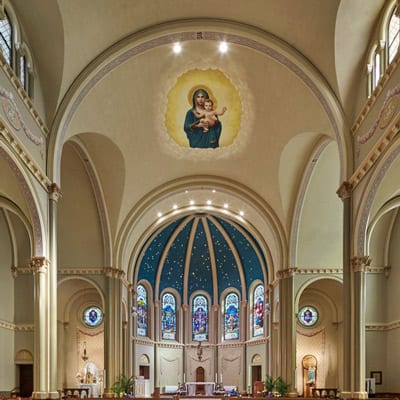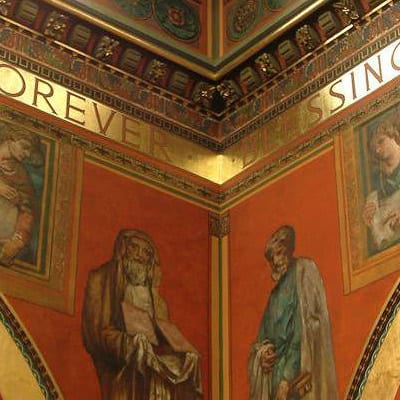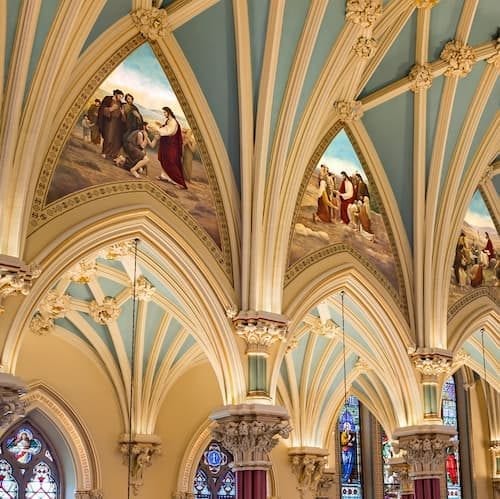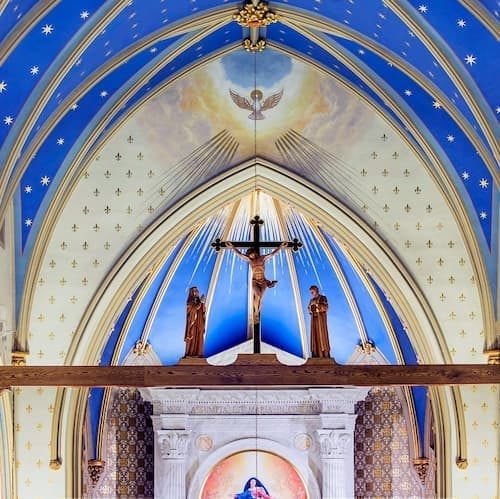Sacred Murals & Commissioned Artwork
In the hands of the craftsman, ordinary materials become extraordinary works of art; all for the same end, to glorify God.
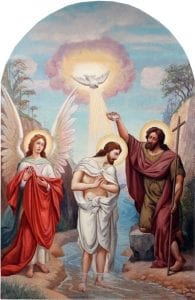
Since the dawn of civilization, art, faith, and iconography have been inextricably entwined, for obvious reasons.
As a liturgical tool, art fulfills many duties and roles. It inspires parishioners to prayer and toward a life congruent with faith. It is instrumental in teaching children and visitors the doctrines of faith. It binds a parish and community together under one belief.
At its most powerful, it carries the potential to touch an individual in their most troubled of moments, soothing an injured soul and even potentially reinvigorating their faith in a moment of doubt.
With this is mind, it is clear that there may be many reasons that you might consider restoring an existing mural, fresco, or other piece of liturgical artwork—or commissioning one from scratch—for your sacred space, whether that be a church, synagogue, temple, etc.
Canning liturgical artisans and artists are students of sacred symbolism and iconography, and accomplished fine artists experienced in illustrating stories from Christian doctrine, with more than 45 years’ of experience preserving, conserving, restoring, and designing murals and other decorative works for sacred spaces.
Testimonials
“The firm’s knowledge of historic finishes, their attention to the minute detail of every feature, the consideration they give to all documentation of original features, from historic photographs to paint sampling, and their dedication to appropriate restoration are impressive.”
— ANDREA F. SCHOENFELD, VICE PRESIDENT, COSMOS CLUB HISTORIC PRESERVATION FOUNDATION, WASHINGTON DC
“Canning’s thorough knowledge of period decoration and methodology, as well as traditional materials, was a valuable contribution to the project team.”
— AMANDA EDWARDS, PA-AIC, LEED GREEN ASSOC., JOHN MILNER ASSOCIATES, INC. ARCHITECTS, ARCHEOLOGISTS, PLANNERS, ALEXANDRIA, VIRGINIA
“Finding remnants of original decorative patterns that had been whitewashed for 75 years. [John Canning Co.] restored them to their splendor and created a beautiful worship space for the present day community.”
— JOHN I. MEYER, AIA, MEYER & MEYER ARCHITECTURE AND INTERIORS OUR LADY HELP OF CHRISTIANS CHURCH, NEWTON, MASSACHUSETTS
Our Process


The exact process that our artisans follow in the creation of sacred murals and liturgical artwork will vary depending upon whether the artwork is a brand new design or a project focused on the conservation/preservation/restoration of an existing work of art. You can learn more about the unique steps involved in each of these below.
Regardless of whether the project is focused on conservation, preservation, restoration, or new design, our process always begins with the development of a thorough understanding of the goals of the engagement. What is being pursued, and why is it being pursued? Once this is answered, we then seek to understand the broader cultural and historical context of the sacred space within which the artwork will live, in order to ensure that the final product is one that fits the space.
Conservation, Preservation, and Restoration
When a project is focused on the conservation, preservation, or restoration of an existing mural or artwork (for example, one that has been damaged, covered over, or worn by time), the engagement will typically begin with archival research to inform us about the history and original intent of the artwork, as this may influence the conservation efforts.
We will then evaluate and thoroughly document the existing conditions of the artwork in order to recommend a plan of action that aligns with your goals.
- What pigments, mediums, colors, and finishes were used?
- What, if any, damage exists?
- Was the mural painted directly onto the plaster substrate, or on canvas, linen, or burlap and maroflaged to the surface?
- What is the condition of the structure underlying the painted work?
- What other components of the space (lighting, furnishings, stained glass, etc.) must be taken into account in order to ensure that the final work is harmonious?
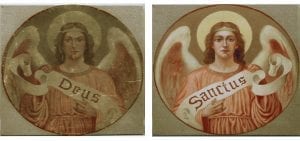

With this understanding gathered, our artisans will utilize harmless cleaning solutions to remove incompatible varnishes and overpaint and years of accumulated filth in order to restore colors to their original brilliance.
Where possible, original paint that has flaked, chipped, or peeled away may be stabilized and reattached. In areas of losses, the artwork would be carefully inpainted, consciously avoiding the danger of overpainting and only inpainting the most necessary areas. Our conservators will then apply protective, reversible coatings to the artwork in order to protect it from further deterioration and damage.
Any work performed by our conservators follows a preservation approach and is kept reversible, adhering to the AIC Code of Ethics.
New Design
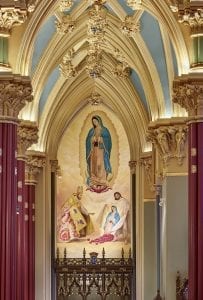

To facilitate this, we will often ask questions like:
- When was the church built, and in what style?
- What other decorative elements, if any, exist within the church?
- What colors, iconography, and symbolism is already prominently displayed?
- What is the significance of this iconography, and is it typically found in relation to other symbolism?
Armed with this understanding, our artisans will create an initial sketch of the proposed design and propose a color palette for the new decorative elements.
Pending approval of the proposed design, the next step is to create a mockup, or maquette, of the artwork that will allow you to better visualize the completed mural or artwork. Additionally, mockups bring a number of other benefits, and can be a powerful tool in fundraising and design. Following approval of the mockup, installation of the final work can begin.
Our conservators are skilled in the recreation of notable styles of decoration which are commonly found in churches and other sacred places, such as:
- Chiaroscuro
- Byzantine
- Pre-Raphaelite
- Art Nouveau
- Hudson River School
- Plein Air
- Realism
While the exact techniques used will of course depend upon the project, our artisans are experienced in:
- Complex Stenciling
- Pounced Cartoons
- Freehand Artwork
- Trompe L’oeil
- Simulated Stone (Faux Marbre)
- Wood Graining (Faux Bois)
- Gilding & Glazing
As the ethnic mix of congregations change, we can create new work matching existing styles to represent miracles and apparitions present in the Christian heritage of diverse cultures. For mid-century era churches, we sensitively integrate traditional sacred design elements into the more sterile environments from that period.
Cost Factors
When it comes to cost factors for our mural painting services, there are many considerations which may impact the final expenses of a project. Some of the most important will include:
- The size, complexity, and scope of the overall project, including whether the project includes a single larger painted work or multiple smaller works
- The specific solutions, pigments, and finishes which will be required to complete the work
- Whether or not investigation or analysis must occur before painting begins (such as a historic paint and finishes investigation or plaster conditions survey)
- Whether the underlying structure must be repaired, stabilized, or restored
- Whether the project will entail preservation and restoration, or if it is brand new
- Accessibility (for example, whether or not scaffolding will be required to complete)
- For projects located in public spaces, whether the work will take place during business or off hours
For these and other reasons, it is very difficult to give an example of what a “typical” or “average” mural project might cost. The easiest way to get a clear picture of what the budget for your project would look like would be to contact us directly for a consultation.
Our Specialties
In addition to sacred mural painting, design, preservation, and restoration, we specialize in a number of other complementary services, including:
- Historic Paint Analysis
- Plaster Conditions Survey
- Conservation & Restoration
- Project Planning & Management
SELECTED PROJECTS
We were able to uncovered original colors, patterns, and finishes to conserve 24 murals while restoring Stations of the Cross and the scagliola columns.
Saint Mary’s Church required both paint and plaster investigative studies to assist in the plaster and decorative paint work that was needed.
The Our Lady of Fatima Adoration Chapel project involved Canning Liturgical Arts enhancing the small worship space with sacred imagery and art.
We provided design assistance, which included finishing investigations for the fine and decorative artwork in the Trinity Church’s Central Tower.
Using a variety of gilding, transparent glazes, and metallic paint, our final product illuminates the sanctuary adding visual interest for the congregation.
We provided a new decorative scheme that articulates the architecture, reflects a Marian theme and represents the finest historical, traditional liturgical design.


